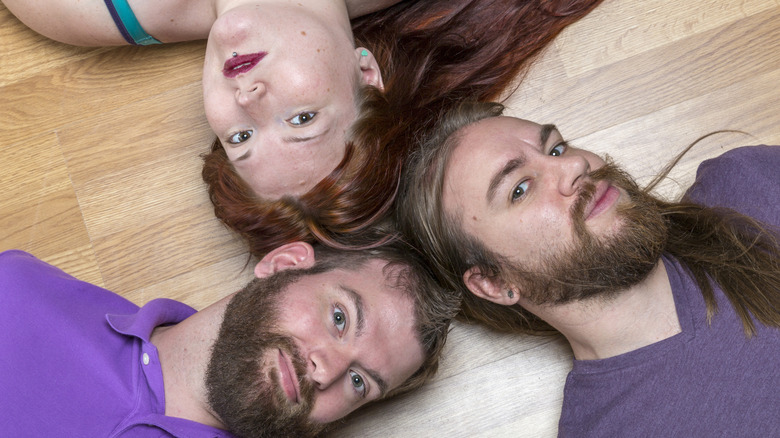What Is A Vee Relationship Structure In Polyamory, And Will It Work For You?
As more and more people eschew conventional relationships, other ways to love and express commitment are coming to the forefront. We have reached a place in our society where non-monogamous relationships are far more accepted than they were in the past, so those who know they have a lot of love to give and practice compersion — finding happiness in knowing their partner is experiencing pleasure with someone else — are branching out and finding other relationship structures that work for them.
According to a 2021 survey published in Frontiers of Psychology, roughly 10% of people have been in some form of a polyamorous relationship and 16% want to give it a try, but just haven't made the jump yet.
Although there is no one way to have a polyamorous relationship, as long as there's communication and mutual respect throughout, they are divided up into types. One of these is called the "vee," as in the V-like structure it makes. In this type of relationship, one person is the vee who acts as the hinge between two people. While the vee has a relationship with both people, those two people do not have a relationship with each other, thereby making them one another's metamours — meaning they're their partner's partner. While the metamours know that each other exists, they don't necessarily have any connection. They could be BFFs or total strangers.
Will being in a "vee" relationship work for you? As much as it might seem like a fantastic idea to have more than one partner, there are things to consider before launching yourself into a polyamorous relationship.
You have an understanding of polyamory
When it comes to polyamorous relationships, you can't just blindly go into them thinking it's all fun and games, because it's not. Polyamory isn't like relationship anarchy in which the rules are loose as long as there's respect for everyone involved. To be polyamorous, means having more than one relationship at a time based on the belief that people are capable of loving more than one person at a time.
While having sex can be part of the equation, people don't go into polyamory with the mentality that they're going to get to have sex with more than one person. It's more about being able to love multiple people and doing so in an ethically non-monogamous way. It's about understanding and practicing compersion, having the ability to communicate clearly and effectively, and being open to possibilities — as in the fact that your partners will likely have other partners too.
You want to be ethically non-monogamous
If you want to be in an ethically non-monogamous (ENM) relationship, you need to understand what that means — as in, what it really means. You can't just breeze into an ENM without guidelines, rules, and openness. Everything must be discussed with your primary partner and there's no holding back.
"When explaining ethical or consensual non-monogamy to my clients, my go-to is the three C's: communication, consideration, and of course, consent," psychotherapist Cheyenne Taylor, LMSW tells Mind Body Green. "Ethical non-monogamy is based on the concept of using socially acceptable guidelines and ethically motivated tools to cultivate a relationship built on the foundation of non-monogamy. At its core, though, ENM means not cheating or acting without the consent of your partner."
Whether you're the hinge in the vee structure or a metamour, you need to be comfortable with sharing your partner. The hinge may have one primary partner in which they have an ENM, while the other partner isn't secondary, per se, but they're not the primary. It's also possible that both partners of the vee are considered primary and ENM, so they have their own partners as well.
You're open to sharing partners
Because the vee structure makes the shape of a V, the understanding is that as the V in the relationship only has two partners — otherwise, it's no longer a V shape. While the vee may only have two partners, if you're a metamour, then you may have a relationship with the vee and others. If you're someone who feels they have a lot of love to give, then being the hinge in a vee relationship structure isn't the best place for you and you may want to explore other structures that might be a better fit: triad or quad.
As a triad, the three people within the primary relationship may date other people outside their relationship, either together as a group or independent of the primary relationship. In a quad, it's the same set-up, but with four people in the primary relationship. Although a triad and quad allow for more than two partners, it doesn't mean that this relationship isn't without its own set of rules, boundaries, and the necessary consent from the primary relationship. Again, it's important to realize that just because you're engaged in polyamory as your relationship style of choice, it doesn't mean that it's a free-love system like a weekend at the 1969 Woodstock event.
You like the idea of being at the center of a polycule
While not every vee relationship may find itself at the center of a polycule, if the two partners of the initial vee (hinge) have other partners of their own, then that may eventually be the case. In a polycule, there's a vee that sort of holds together the whole structure. As the vee, they only have two partners, but their partners may have partners, their partners might have partners, and so on. Although a vee relationship may not know the other people in the extended polycule outside of their partners, the fact remains that the vee relationship, especially the hinge within that relationship, is at the core of all those branches. In other words, you're part of a polycule.
What a lot of people don't understand about polyamory is that it takes a lot of work. You're not only sharing your love, but sharing your time, your emotional, mental, and physical energy, and sticking to a set of rules that you have either set for yourself or have agreed upon with your primary partner(s). It's not something you fall into or leap into without knowledge and understanding of how it all works. Although polyamory, in all its structures, is a beautiful thing, without the necessary research and communication, it can become a place of hurt and mistrust. If you want to avoid the possibility of having your heart broken or breaking someone else's heart, you definitely want to know exactly what you're getting into and what structure is best for you before you start inquiring about polyamorous relationships.




